#cobla
Text
People dancing a sardana in la Bisbal de l'Empordà's town square, Catalonia. Video by Amics de la Sardana Terranostra.
This is sardana, a type of music and dance from Catalonia often considered Catalonia's national dance.
The music for the sardanes is always played by a cobla, a specific music ensamble consisting of 11 musicians playing 12 instruments with a predominance of wind instruments.
There are many songs of the sardana genre, all of which share the same beat. For this reason, the same handful of dance steps can be used for all songs. The dance is easy on purpose, so that everyone can join. It consists of two basic steps called the “short step” and the “long step”, and it’s always danced in circle holding hands.
The circle represents friendship, harmony, fraternity and solidarity among everyone who joins to hold hands.


People dancing sardanes in Northern Catalonia. Photos from the article “Sardane, une ronde fraternelle en Pays Catalan” by Béatrice Bantegny on Visit PO.
In the late 19th century, authorities (government and religious) condemned the sardana for being immoral because it meant that men and women who aren’t relatives were holding hands, but it was too popular to control it. During Franco’s fascist dictatorship of Spain (1939-1978), some sardana songs were banned because they were considered too Catalan (one of the pillars of Spanish fascism was/is Catalanophobia, the dictatorship wanted to exterminate the Catalan language, culture, and identity and impose the Spanish one instead).
But sardanes kept being danced through all of it and nowadays you can still find that a cobla plays in most towns during its local festivities, and everyone can join and dance. Though in most of Catalonia this dance is now associated with elderly people, in the Comarques Gironines it's particularly beloved. In the Empordà area, you can often find it in summer evenings.
#sardana#sardanes#música#dansa#arts#catalunya#folk dance#folk music#cobla#traditions#culture#cultures#europe#travel#wanderlust#la bisbal d'empordà
44 notes
·
View notes
Text
Fête de Pasquettes : sardanes et chasse aux œufs
Fidèles aux traditions, le Centre Culturel Catalan et la ville de Pollestres perpétuent, chaque année, cette occasion de se réunir et de célébrer nos racines. La fête de Pasquettes, chère aux Pollestrencs, est célébrée le dimanche après Pâques, notamment cette année, le dimanche 7 avril. On y célèbre le Printemps, l’arrivée des beaux jours, les couleurs envahissant nos paysages, le plaisir d’être…

View On WordPress
#chocolat de Pâques#cobla#danses catalanes#enfants#Fête de Pasquettes#Journal Catalan#Le Journal Catalan#oeufs#paques#Pollestres#Pyrénées-Orientales#sardanes
0 notes
Text
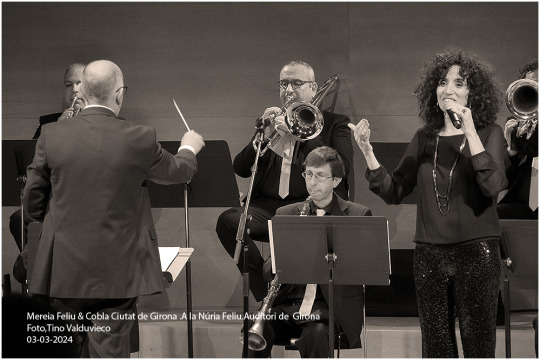

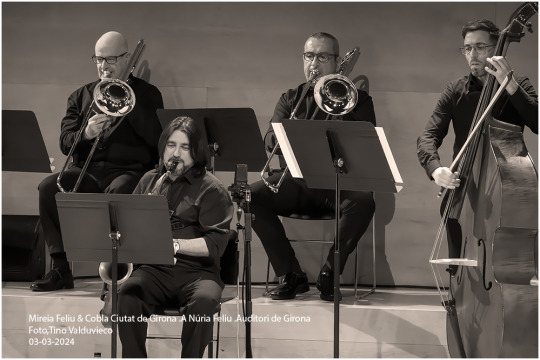

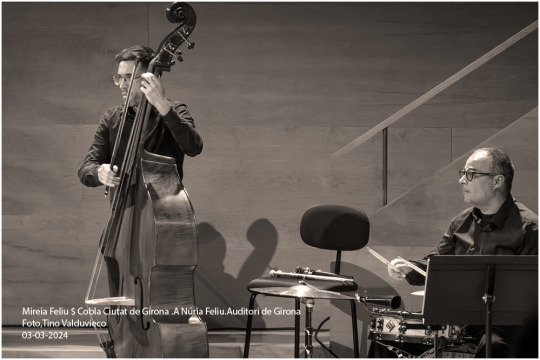

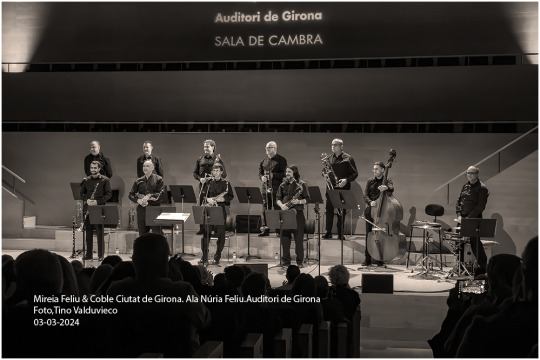


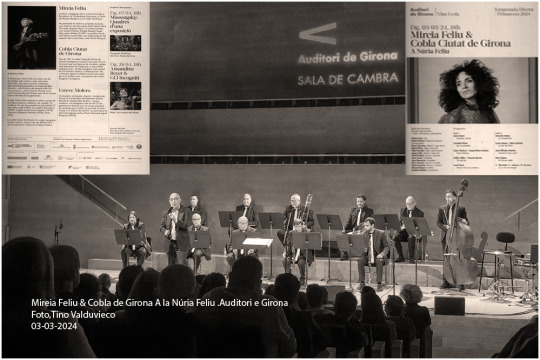
Mireia Feliu & Cobla Ciutat de Girona .A Núria Feliu amb sentiment.
Auditori de Girona 03-03-2024
©Tino Valduvieco
0 notes
Photo
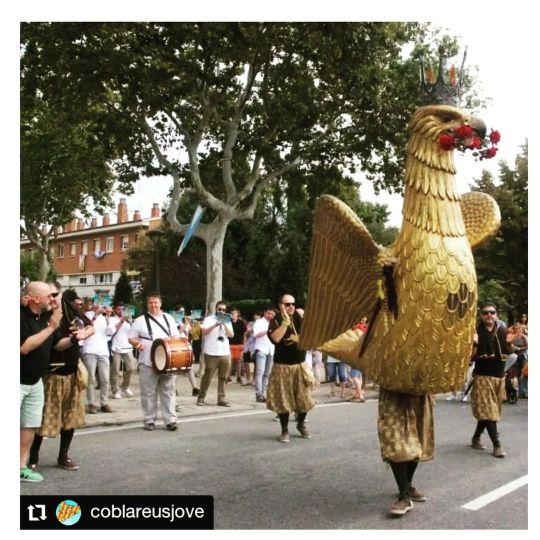
#Repost @coblareusjove • • • • • • Diumenge 25 de setembre Festa Major de Reus. Cap a les 12 del migdia baixada des de la Pastoreta i pel passeig fins al Santuari. A les 17.30h ballades a la plaça del santuari dels elements del seguici, música alegre i festiva amb so de Cobla per fer ballar la nostra estimada Àliga de Reus. A les 19h castells i tot seguit, a l’interior del SANTUARI, l’Àliga de Reus (@aligadereus) oferirà a la Mare de Déu de Misericòrdia el seu ball solemne curt amb l’acompanyament musical de la Cobla Reus Jove (@coblareusjove) També es podrà gaudir de la cançó i mantuana (música antiga de l'àliga) que només s'interpreta un únic dia a l'any, mentre entra pel passadís central a l'interior del temple. Un cop fet el ball i l'ofrena a la Mare de déu. Cantada general dels goigs de la Mare de Déu de Misericòrdia a càrrec de l’Orfeó Reusenc (@orfeo_reusenc) i els fidels assistents, amb l’acompanyament musical de la Cobla Reus Jove. #ferdemúsic #tour2022reusjove #festamajor #músicaperacobla #Misericòrdia2022 #Cobla #Reus __________________________ #AligaDeReus #AligaDeCatalunya #AliguesDeCatalunya #Aliga #Aguila #Aguiles #Aligues #BestiariPopular #FiguresZoomorfiques #ImatgeriaFestiva #CulturaPopular #BestiariFestiu #BallDeLAliga #CoblaReusJove #FMMisericordia22 (en Reus) https://www.instagram.com/p/CiweLStNd69/?igshid=NGJjMDIxMWI=
#repost#ferdemúsic#tour2022reusjove#festamajor#músicaperacobla#misericòrdia2022#cobla#reus#aligadereus#aligadecatalunya#aliguesdecatalunya#aliga#aguila#aguiles#aligues#bestiaripopular#figureszoomorfiques#imatgeriafestiva#culturapopular#bestiarifestiu#balldelaliga#coblareusjove#fmmisericordia22
0 notes
Text
wowza....piękne jaskinie i wąwozy w mojej okolicy!?!?!?
#nadal się trochę boję jaskin bo no. ciemno i tak dalej brrr ale kocham je też bardzo <3 yay#30 staków cobla?? w moim ekwipunku?!?!?!?!#nie wiem czy celowo jest ich tak dużo czy taki seed/biom/nwm nie znam się. w każdym razie super nie narzekam
5 notes
·
View notes
Video
youtube
Concurs de colles sardanistes. Rosselló amb la Cobla Jovenívola d'Agramu...
#youtube#Concurs de colles sardanistes. Rosselló amb la Cobla Jovenívola d'Agramunt 2024#lleida#catalunya#españa
0 notes
Text
Hey hello I made a thing! As perhaps a few of you know, I have spent the last half a year being completely unhinged about Patrick O’Brian’s Aubrey-Maturin books, and I’ve always been particularly interested in the character Stephen Maturin and his relationship to Catalonia. I saw that there was a lack of stuff about this part of his identity, and, being me, I felt the need to fill it in the only way I could: compiling music and yelling about it for thirty pages. Hence this playlist.
You really don’t need to know anything about these books to listen to this playlist. You also don’t need to know anything about Catalan (I hope). Catalonia and the Catalan Countries in general (including Valencia, the Balearic Islands, and parts of southern France, Aragon, and Sardinia) have a really interesting musical and literary tradition, and I wanted to make that more accessible, so I put together a few songs I liked, translated them, and wrote a bit about each of their significance, including the most important cultural tidbits I could. Some things don’t translate super well, and I hope my Catalan followers will forgive me for trying to adapt them more for English-speaking audiences than perhaps would be preferable; I usually don’t choose to do that, but in this case I wanted to open the door, and not to intimidate people.
Now that that’s out of the way, here is a link to the PDF of the liner notes (graphic design is my passion, as they say): https://drive.google.com/file/d/1MUpRM84W8aypznEIrt0eA1jG5OxaRZvz/view?usp=sharing
Under the cut I’ve included the ephimera and unnecessary commentary that you know and love, feel free to read or ignore it as you will
These roughly follow the order of the songs and are varying levels of seriousness
If you like "Sant Joan, feu-lo ben gran" then I'd highly recommend listening to the whole Tornaveus album. I almost included the “Stabat Mater de Sudanell” and the “Goigs de Sant Julià de Lòria”, which are both from western Catalonia, and they also have more cançons de pandero, in perhaps a slightly more traditional style. A lot of the other songs have interesting cultural commentary in them, especially on feminist topics, and they’re very well-researched because literally one of the members of the group is basically the ethnomusicologist of Catalan music at the moment. Anyways, if people would like the liner notes perhaps next time I’m home I’ll scan them, they’re in Catalan and English and very well-written. Also note the legendary Lluís Llach song which has been turned into a polyphonic piece lol (and I did not include the “Goigs de la Nostra Senyora de la Llibertat” but tbh that might have been a mistake on my part) (Blorbo side note that I think this fits Stephen’s childhood very well which is mostly why I chose it)
“L’Hereu Riera” is one of my favorite Catalan folk songs I love it so much and if you want to hear the Catalan version (as opposed to the Valencian one included here) and see the dance and also see a cobla, I am including a link to this version by Germà Negre which is tragically not on Spotify. I chose the Valencian one because (1) Al Tall and (2) I think it fits The Blorbo better (specifically I was thinking of his fiancée who dies before Book One who idk if anyone ever remembers shdjfhskf). That being said, Stephen would probably know the Catalan one (and almost certainly not the Valencian one). Also, on a memey-er note, Hereu Riera bisexual king and literal icon <3 love how he has to remind his girlfriend on her deathbed that actually he'd technically be interested in both her sisters AND her brothers if he wasn't so into her that he never wanted to marry anyone else
I literally did put in Roger Mas just so there would be at least one person with a Lleidan accent, #diversity win
Many points about the “Cançó de pandero de l’Urgell” and “Jo no canto per la veu” so here we go:
I put these two songs in mostly because I got very obsessed with the cançó de pandero from Alcarràs (which is a great movie that came out last year about a farming family in a village near Lleida that is winning all the awards atm). Anyways, since Carla Simón has been too busy winning things to put up the gotdam soundtrack, I did a bit of digging and it turns out that it was written for the movie?? By her brother??? It's excellent and very anticapitalist and you can listen to it here and see the trailer for Alcarràs all in one! (Includes English subtitles)
The original “Canto per un amic meu que per mi daria la vida” is probably from a Valencian cant de batre, although I could not get any confirmation on that. But regardless everyone should listen to Pep Botifarra's version of it, which I would literally marry if it had a physical form it’s so so good. (I posted it here back in ye olden days but it's been long enough I think I can post it again)
Valencian music side note because I can’t stop myself: the second pair of verses in the "Cançó de pandero de l'Urgell" (starting with “vos esteu ben acotxada…”) are sung by Miquel Gil, who is a very famous Valencian traditional singer, anyways you should listen to this version of him singing “Del Sud” by Obrint Pas (you want to go down a Valencian music rabbit hole so so bad)
I firmly believe that Stephen would canonically be obsessed with Ausiàs March, and the fact that he has not yet recited any of his poems is Patrick O’Brian’s biggest failing in my eyes. Anyways I have more thoughts but I’m saving them for other posts shdfjsd
If you read this before listening to the playlist please just listen to "El testament d'Amèlia" and follow along with the lyrics in real time before reading the blurb, it's such a good experience to let that song hit you as it comes. I won't say more than that but you'll get it when you get it. (Also obligatory listen to Marala they're so good <3)
From the Càntut album, I also quite like the songs "El pomeró" and "El divino vull cantar", and Càntut in general is an incredible resource, it's a database of folk song field recordings from northeastern Catalonia.
Brief pause to scream about the fact that Maria Arnal and Marcel Bagés WERE ON NPR??? AND NO ONE TOLD ME???? Anyways link in the sources section, also they're great and you should listen to their whole discography
As the #1 Roba Estesa stan blog on Tumblr, listen to Roba Estesa. And Ebri Knight. And El Diluvi.
I chose this version of "La presó de Lleida" because I like it but here's a more traditional one sung by Joan Manel Serrat, another Catalan legend. Here's another one in Catalan rumba style with Sílvia Pérez Cruz singing, the sound is a bit wonky but it's also one of my favorites. The Valencian version of this song is called "La presó de Tibi" and El Diluvi have done a very explicitly anti-monarchical rendition of it (the Balearic one is "La presó de Nàpols").
I'm sorry for never putting the Sílvia Pérez Cruz version of "Corrandes d'exili" but if you want it here it is. Also note that the statue of the Virgin in the poem is a reference to the Virgin of Montserrat, it literally all goes back to her shfjkshdf (also apologies for being very bad at Christianity and Catholicism, if I mistranslated things let me know)
HOO BOY SARDANA TIME
Okay so I have a whole essay to deliver on this that I've been holding inside for the past like two months or so, I apologize in advance for my excessive pedantry on the topic.
In Master and Commander, Stephen delivers this speech:
"‘Then I must tell you that on Sunday mornings it is the custom, in that country, for people of all ages and conditions to dance, on coming out of church: so I was dancing with Ramon Mateu i Cadafalch in the square before the cathedral church of Tarragona, where I had gone to hear the Palestrina Missa Brevis. The dance is a particular dance, a round called the sardana.’"
I hate to be a hater but it is very, very unlikely that anyone would have been dancing a sardana as far south as Tarragona in this time period. The sardana as the symbol of equality and brotherhood emerged in the Renaixença and would not yet have been a thing; Stephen could well have heard sardanas in Ullastret, but they would have been a more typical folk dance, and not anything like the way they're described in the book. It's very ironic, then, that they've become THE Catalan music style for Aubreyad readers, but hopefully this playlist can change that a bit :)
(also sorry for being a sardana-hater on main, someone bring me to dance a sardana and maybe I'll feel better)
Songs that didn't make the cut: La cançó del lladre, Rossinyol que vas a França, La balanguera, La gavina - I'm always happy for more recs!
Originally, this list was also going to include songs in Irish; I quickly realized that I was in over my head with that one, but the working list of songs is here (may be subject to changes so save songs elsewhere if you like them!). Also I would add "Fé Bhláth" by Imelda May and Kíla if it was on Spotify but alas it is not; and "Amhrán na Leabhar" which I have not had time to add but was kindly recommended by someone. I'd love it if someone was interested in actually doing a proper playlist for Irish though—it's a gap in my knowledge that I'd love to start filling.
Aaaaaaand that's a wrap. I hope. Final comment to say thank you to everyone who voted in the cover image poll, turns out you all won :) (Pirineus did win and take the cover of the liner notes though)
#my masterpiece is done i have peaked i'm retiring now#jkjk but i've been working on this since like. november#so it is kind of insane that's it's finally done#please notify me of any mistakes or corrections <3#and hopefully this is enjoyable for you all!#it's a little funky at times but i think it works???#it's not really a playlist. it's more like one of those weird compilation albums that i definitely didn't consume too many of as a child#did kind of want this to show up in the aubreyad tag but i wanted links more so rip :// anyways here goes nothing#aubreyad#catalan#catalan:general#catalan:music#catalan:reference#catalan:culture#general:music#general:reference#general:culture#there'd better not be any typos or i'm fighting someone
86 notes
·
View notes
Text
La invención del amor, un asunto literario: de amor cortés y melodrama.
Diccionario Español de Términos Literarios Internacionales.
Apunte para 11/03
La expresión "amor courtois" fue acuñada por Gastón París en 1883. Siete siglos antes Peire d´Alvernhe (c. 1130 - c. 1170) había hablado de "cortez´amors".
Se llama cortés a esta literatura porque originariamente se dirige a un público de corte, además de evocar la cortesía exquisita y el refinamiento propio de la sociedad cortesana aristrocrática.
Del ideal del amor cortés, está el caballero cortés, valiente guerrero que no combate por dios ni por su rey, sino por su dama. Esta literatura tendría su auge entre los siglos XII y XIII, prolongándose hasta el XVI, y extendiéndose como ideal, sin ser una representación realista de la vida aristocrática.
El amor cortés oscila entre el deseo erótico y la superación espiritual; un amor a la vez ilícito y moralmente elevado, apasionado y disciplinado, humillante y exaltante, humano y trascendente. Dificultad en la discusión hay sobre incluir entre sus características principales el adulterio, pues Huizinga acierta en que el deseo insatisfecho se convierte por primera vez en tema esencial para la concepción del amor.
Exponiendo la visión idealista:
El servicio del amor. Sentimiento noble y puro que da sentido a la vida. Impone deberes de homenajes y sumisión, pues el amante es servidor y la dama soberana. El amor es secreto, la identidad camuflada en palabra o poesía.
Leyes de amor.
1. Amor-virtud: Admiración recíproca entre caballero y dama. Él, belleza, bondad y gentileza. Ella, valor de guerrero, elegancia y carisma. Se desprende entonces el empuje hacia una perfección estética y moral.
2. Amor-religión: La dama es una divinidad que eleva el alma de los caballeros.
3. Amor-ciencia: El amor cortés es una filosofía y ciencia sólo accesible a los iniciados. Hay que aprender a amar bajo la dirección de los maestros con lealtad y fidelidad, no dejando de lado la discreción. El verdadero amor se desvela por sí mismo aspectos físicos de las personas.
Recompensa del amor. El amor cortés es también pasión reflexiva, exigente y secreta. Somete al caballero a largas y difíciles pruebas. Conservará reliquias con gran admiración y se contentaría con algún testimonio de amistad como una sonrisa o una acogida amable.
En la consideración menos idealista del amor cortés, como podría ser la exposición de Capellanus, encontramos que ha de ser necesariamente extramarital, ya que el matrimonio conlleva el contrato entre familias y clanes. Lewis nota la especialización del amor cortés y define como sus características fundamentales la humildad, cortesía, adulterio y religión de amor.
Los hombres mayores buscan ser premiados por sus hazañas, mientras los hombres jóvenes de bajo nacimiento piden en el amor inspiración para realizar hazañas.
Capellanus describe también a las monjas como fáciles de seducir, aunque condena a quien lo haga y le llama "animal repulsivo". Me causó gracia mencionarlo.
En el nacimiento de la literatura cortés medieval concurren cuatro
fuentes: la provenzal, la bretona, la grecolatina y la anglo-francesa. La fuente provenzal (los trovadores) se manifestará sobre todo en la poesía lírica. En cambio, las fuentes bretona, grecolatina y anglo-francesa se manifestarán sobre todo en esas amplias narraciones en verso (y después en prosa) que son los romances.
Los trovadores son poetas itinerantes que versifican en lengua romance occitana, y buscan la subsistencia y la gloria en las ricas cortes de los castillos del “Midi” de la Galia. Los trovadores constituyen la primera escuela poética en romance con alta exigencia artística, lo cual es una gran novedad. Por otra parte, tienen identidad conocida, frente al anonimato de la poesía anterior.
Tras dos siglos de poesía esplendorosa, el último testimonio de los
trovadores es un intercambio de «coblas» entre Federico III de Sicilia y Ponç Hug de Ampurias (1298). El final de los trovadores tuvo una razón política: Francia se anexiona las ricas cortes feudales del “Midi” con el pretexto de una cruzada contra los albigenses (1209-1229).
0 notes
Text
"Cuando toco, trato de contar algo"

[La pianista Sofya Melikyan (Ereván, Armenia, 1978) / JAIME GALERA PÉREZ]
La armenia Sofya Melikyan presenta el próximo miércoles en el Espacio Turina su último disco, que dedica a la figura seminal de Ricardo Viñes
Aunque nació en Ereván, la capital armenia, en 1978, Sofya Melikyan llegó a España con sólo 15 años y aquí tuvo buena parte de su formación musical. Ahora vive en Estrasburgo, pero su último disco está dedicado a una figura española esencial en la música de principios del siglo XX, el pianista Ricardo Viñes.
–Hace 80 años que murió Viñes. ¿Ha tenido que ver el aniversario en el CD?
–No en realidad, aunque es cierto que la figura de Ricardo Viñes me ha fascinado siempre. Llevo muchos años trabajando sobre esta música francesa y española de principios del siglo XX. Me interesan mucho esos recursos colorísticos del piano. Además eso coincidió con mi estancia de cinco años en la Occitania. Acabo de mudarme a Estrasburgo, pero los últimos cinco años los pasé en el sur de Francia. De Occitania era original Déodat de Séverac. Allí conocí más profundamente su mundo sonoro. Leí su música cada vez con más interés. Se juntaron las dos cosas: el creciente interés mío hacia Déodat de Séverac y el que tenía de antiguo hacia Viñes. Había tocado ya obras de Séverac, entre ellas la suite En Languedoc, presente en el disco, y así me surgió la idea, buscando conectar todas estas músicas de principios del siglo XX, porque Fauré es un compositor que también me interesa y había tocado ya mucho. El vínculo de todas estas músicas fue Viñes, no sólo como pianista, con obras que estrenó, con obras que le fueron dedicadas, sino también como compositor, una faceta suya muy desconocida, entre otras cosas, porque tiene muy poca música: aparte de estas cuatro piezas que he grabado, creo que tiene sólo tres canciones para voz y piano.

–¿Por qué no se programa apenas Séverac?
–Posiblemente porque era una especie de outsider, él luchó toda su vida contra la centralización de la vida cultural francesa, en la que todo tiene que pasar por París. Parece que si lo que se hace no parte de París no existe. Tuvo una relación muy estrecha con su tierra. Nació en un pueblo cerca de Toulouse, luego fue a París para estudiar en la Schola Cantorum. Fue asistente de Albéniz y se hizo muy amigo suyo. En Albéniz la geografía es también muy importante, Iberia, por ejemplo. No es como cuando hablamos de un nocturno de Fauré, música abstracta, en la que el aspecto geográfico no es importante. Tanto en Albéniz como en Séverac la presencia del paisaje es importante. Séverac vivió en París, se movió en sus círculos artísticos, pero en 1910 abandonó la ciudad y se volvió al sur, para instalarse en Céret, una ciudad de la Cataluña francesa, un centro de cultura, pues allí tuvo una casa Picasso y por allí pasaron Gris, Braque, Max Jacob, hasta convertirse en una especie de centro del cubismo y del modernismo. Séverac pasó allí el resto de su vida y su música está muy vinculada a ese espacio geográfico. Él no aceptó esa centralización de la vida cultural en Francia y por eso fue muy criticado, y esa sombra perdura hasta hoy. Tengo la sensación de que no se le considera por eso. Es verdad que está muy ligado al patrimonio cultural occitano, pero su música no se puede simplificar por ello, es universal. Sobre todo es músico, en su obra no se sustituye la percepción auditiva por la visual. Su música es profunda e imaginativa, y por eso crea una asociación poética muy grande. Se le considera también un impresionista, en la misma onda que Debussy o Ravel. Es un compositor que me interesa mucho, me fascina de alguna forma, sobre todo esta suite, En Languedoc. Luego hay obras que escribe ya en Céret, como Cerdaña o El canto de la tierra en las que hay mucha influencia de la cobla catalana, y es música que no tiene ya esa ligereza impresionista, es como más pesada.
–¿Y la música de Viñes?
–No conocía su música hasta hace tres años, en que la escuché en un disco que había grabado Joaquín Soriano, junto a Mompou y Falla. Estas piezas son como unos gritos de su alma, una dedicatoria a personas cercanas, con las que tenía mucha amistad, tres compositores (Ravel, Fauré, Satie) y el escritor Léon-Paul Fargue. Son piezas un poco de salón, pero muy espontáneas. Usa muy bien sus recursos como pianista, la relación entre los bajos y el registro agudo, melodías muy cercanas a la escuela francesa, a lo que él llamaba los armonistas, Ravel, Mompou, Fauré, gente que buscaba sonoridades nuevas pero agradables para el oído. Vivió en París casi toda su vida, aunque al final volvió a Barcelona, donde murió. Pero debajo de todo esto hay un alma ibérica, en el fondo era muy español: sus melodías están teñidas de esa melancolía tan característica del alma ibérica. Son piezas muy bien escritas por alguien que conocía extraordinariamente el instrumento.

[Sofia Melikyan. / LIDIA SEAONE]
–La obra de Satie tampoco es muy frecuentada...
–No. La escogí porque fue estreno de Viñes. Son como tres bromas, tan típicas de Satie, este sentido del humor un poco salvaje. Está escrita como regalo de cumpleaños para él mismo. Se ríe de su entorno, el tercer movimiento, el rápido, es por ejemplo una parodia de una marcha militar.
–¿El disco estaba planteado como programa de concierto?
–Cuando estaba planeando el disco no pensaba en hacerlo como concierto. Luego vi que había un hilo conductor y que funcionaba muy bien. Tengo algunos conciertos programados en primavera, y voy a cambiar algo: voy a tocar por ejemplo Miroirs entero. Pero es verdad que el programa del disco tiene un carácter atmosférico, y por eso elegí también este título, que está inspirado en el libro de Jankelevitch, un ensayo sobre Albéniz, Déodat de Séverac y Mompou en el que analiza de forma muy poética la música de estos tres compositores, planteando similitudes entre ellos. Me pareció interesante escoger este título porque la línea general es que no es una música que viene y se te impone, sino que viene de lejos y que tienes que hacer incluso un esfuerzo para entrar en su mundo.
youtube
–En sus notas Juan Manuel Viana usa una cita de Cocteau: "Viñes no toca, explica". ¿Se considera una pianista de este estilo?
–Sí, absolutamente. Me gustan los programas temáticos, los que tienen un hilo, pero también la forma de presentar cada obra. Mi intención cuando toco es contar algo, sin duda alguna. Lo más importante es expresar un mensaje. Todo lo demás son medios o recursos para esta meta final que es transmitir un mensaje al oyente.
–¿Algún proyecto nuevo para el disco?
–Sigo adelante con mi idea de grabar toda la música camerística de Brahms con piano: hemos grabado en Alicante el Trío que nos faltaba (el nº1) y una versión de la Noche transfigurada de Schoenberg que hizo un alumno suyo, Eduard Steuermann. Eso saldrá el año próximo.
[Diario de Sevilla. 10-12-2023]
PRÉSENCE LOINTAINE EN SPOTIFY
#sofya melikyan#rubicon#déodat de séverac#ricardo viñes#maurice ravel#gabriel fauré#erik satie#federico mompou#música#music#Youtube
0 notes
Text

ÒRBITA ÉS UNA PEÇA DE DANSA, ELECTRÒNICA I COBLA DE MINISTRERS PRODUÏDA PEL COL·LECTIU FREE'T I L'AJUNTAMENT DE BALAGUER
0 notes
Text
youtube
This song has become very popular in Catalonia. I hadn't translated it before because its lyrics are full of jokes and colloquialisms so it's difficult to translate, but I really wanted to share it.
The Tyets is a Catalan band that makes trap and reggaeton-ish music, but in this song they've incorporated a cobla (traditional ensemble of sardanes, considered the national music/dance of Catalonia) to their urban song. You can hear the characteristic instruments and beat of the sardana in the chorus.
It's quite common among Catalan pop and rock bands to use traditional instruments (mostly the gralla/dolçaina) and some traditional forms of singing (mostly cant valencià d'estil), but sardanes had so far been left out of this because they're often negatively stereotyped as old-fashioned and its popularity among elderly people made it unappealing to the younger generations. However, turns out the familiarity of these sounds still rings close to our hearts, and people (regardless of age) can't help it but to dance when they hear it!
The translation is under the cut.
The lyrics are light-hearted and use a lot of colloquialisms and slang, they joke about gossiping. The title (coti x coti) would be translated to "gossip 4 gossip", but using a slang word for "gossip".
No ho puc evitar, ja no sé com fer-ho
M'ha arribat a les mans, un coti ben salsero
Que ha mogut tot el mercat, no me'l puc treure del cap
Si vols aquest secret, doncs per tres l'has de canviar.
I can't help it, I don't know how to keep it anymore
A very juicy gossip has reached my hands
It has shaken all the market, I can't get it out of my head
If you want this secret, you'll have to exchange it for three others.
Chorus:
No en vull saber res
Intento no creuar-te la mirada
No em crec històries inventades
De tu ja no em puc creure res.
I don't want to know anything about it.
I try not to make eye contact with you
I don't believe made up stories
I can't believe anything you say anymore.
-
Ahir em vaig trobar l'Aleix i em va dir que tenia cotis
Posseïa info, tenia bones refes
No sabia perquè, però s'ajuntaven les notis
El mercat está palmant i tu estàs holding
Yesterday I ran into Aleix and he told me that he had gossip
That he owned info, he had good references
He didn't know why, but news were stocking up
The market is croaking and you're holding.
Tira la manta, peli de terror
No vulguis correr a la sort del traïdor
I esque et miro davant de la platja i em dius que no, que no
Throw the blanket, horror movie
You better not want to run a traitor's end
And I look at you in front of the beach and you tell me no, no.
Que no ho pots evitar, ja no saps com fer-ho
T'ha arribat a les mans, un coti ben salsero
Que ha mogut tot el mercat, no te'l pots treure del cap
Si vols aquest secret, per tres l'hauràs de canviar
That you can't help it, you don't know how to keep doing it
A very juicy gossip has reached you
Which has shaken all the market, you can't get it out of your head
If you want this secret, you'll have to exchange it for three others.
Repeat chorus.
VISCA!
Hurray! (Note: sardana dances end by all the dancers holding their hands to the middle and shouting "visca!" together)
#the tyets#música#arts#sardana#bachata#music#folk music#sardanes#catalonia#urban music#translation#català#coses de la terra#cobla#coti x coti#folk dance
39 notes
·
View notes
Text
Fête de l'espadrille le 31 juillet à Saint Laurent de Cerdans
Fête de l’espadrille le 31 juillet à Saint Laurent de Cerdans
Niché au cœur de la Vallée Verte dans le Haut Vallespir, le village de Saint Laurent de Cerdans, dernier bastion de la fabrication d’espadrille en Pays Catalan organise le dimanche 31 Juillet la 12ème Fête de l’Espadrille.
A cette occasion l’association La Fête de l’Espadrille propose autour de l’espadrille une journée festive avec :
*Un marché artisanal toute la journée de 9h à 18h avec plus de…

View On WordPress
1 note
·
View note
Photo

#Repost @coblareusjove • • • • • • Diumenge 25 de setembre Festa Major de Reus. Cap a les 12 del migdia baixada des de la Pastoreta i pel passeig fins al Santuari. A les 17.30h ballades a la plaça del santuari dels elements del seguici, música alegre i festiva amb so de Cobla per fer ballar la nostra estimada Àliga de Reus. A les 19h castells i tot seguit, a l’interior del SANTUARI, l’Àliga de Reus (@aligadereus) oferirà a la Mare de Déu de Misericòrdia el seu ball solemne curt amb l’acompanyament musical de la Cobla Reus Jove (@coblareusjove) També es podrà gaudir de la cançó i mantuana (música antiga de l'àliga) que només s'interpreta un únic dia a l'any, mentre entra pel passadís central a l'interior del temple. Un cop fet el ball i l'ofrena a la Mare de déu. Cantada general dels goigs de la Mare de Déu de Misericòrdia a càrrec de l’Orfeó Reusenc (@orfeo_reusenc) i els fidels assistents, amb l’acompanyament musical de la Cobla Reus Jove. #ferdemúsic #tour2022reusjove #festamajor #músicaperacobla #Misericòrdia2022 #Cobla #Reus __________________________ #AligaDeReus #AligaDeCatalunya #AliguesDeCatalunya #Aliga #Aguila #Aguiles #Aligues #BestiariPopular #FiguresZoomorfiques #ImatgeriaFestiva #CulturaPopular #BestiariFestiu #BallDeLAliga #CoblaReusJove #FMMisericordia22 (en Reus) https://www.instagram.com/p/CiuKmqNNldl/?igshid=NGJjMDIxMWI=
#repost#ferdemúsic#tour2022reusjove#festamajor#músicaperacobla#misericòrdia2022#cobla#reus#aligadereus#aligadecatalunya#aliguesdecatalunya#aliga#aguila#aguiles#aligues#bestiaripopular#figureszoomorfiques#imatgeriafestiva#culturapopular#bestiarifestiu#balldelaliga#coblareusjove#fmmisericordia22
0 notes
Note
Siiiiii, cuenta alguna historia por favor. Apoyo al anon.
Casi todas son en el bus, cuando voy sentada y frena pero cobla, esas veces siento q voy a dejar mojado el asiento
1 note
·
View note
Video
youtube
Concurs de colles sardanistes. Rosselló amb la Cobla Jovenívola d'Agramunt
#youtube#Concurs de colles sardanistes. Rosselló amb la Cobla Jovenívola d'Agramunt#rossellò#catalunya#españa
0 notes
Text
Visualitza "THE TYETS - ACTUACIÓ PREMIS ENDERROCK 2023 (Coti x coti amb cobla en directe)" a YouTube
youtube
0 notes